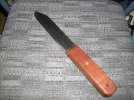When I first started visiting this forum, I was perplexed with all the discussion on batoning. This is something that I seldom did with my outdoors knife, and I wondered by folks seemed to be obsessed with it. Why didn't they carry an axe or a machete?
Now I'm obsessed.
A knife that can withstand all manner of batoning is a strong, reliable knife.
I've brought this subject up following my thread on 'splitting an animal carcase' where it became apparent that batoning may work well for splitting the backbone and separating the chops. Please forgive me if I seem to be harping on. I just want to gather all the information that I can so I thought I'd approach it from a new angle.
So now I want a strong knife for the job and I'm keen to hear your thoughts.
Thinking back, I realize that I have batoned before. I was once in a job where we worked on ventilation systems where there was quite a bit of sheetmetal work involved. Several times I used my Mercator folder to make a hole through the sheetmetal on a building site. I would simply drive it through the metal with a hammer by hitting the base of the metal handle, and then I'd hammer down on the back of the knife. I think I may have broken a knife doing this, but it is amazing how much punishment these comparatively brittle knives would take. Here is a pic of these great little knives:

Looking at the test-to-destruction videos on You Tube, it seems that some well-respected blades can be broken without too much effort. So while some knives have a reputation for toughness, it seems that some might break while chopping or batoning.
When striking the blade immediately above the object being chopped, there is little chance that the blade will fail. But when the blade is buried in the object and the blows have to be made to one side, the knife is more likely to break. When splitting a carcase the blows would have to be made outside the carcase....not directly down on top of the cutting area.
I was thinking that maybe a Becker BK7 or something like it could make a reliable knife for batoning.
What economical knife would you recommend for batoning?
Thanks for humoring me.... best wishes.... Coote.
Now I'm obsessed.
A knife that can withstand all manner of batoning is a strong, reliable knife.
I've brought this subject up following my thread on 'splitting an animal carcase' where it became apparent that batoning may work well for splitting the backbone and separating the chops. Please forgive me if I seem to be harping on. I just want to gather all the information that I can so I thought I'd approach it from a new angle.
So now I want a strong knife for the job and I'm keen to hear your thoughts.
Thinking back, I realize that I have batoned before. I was once in a job where we worked on ventilation systems where there was quite a bit of sheetmetal work involved. Several times I used my Mercator folder to make a hole through the sheetmetal on a building site. I would simply drive it through the metal with a hammer by hitting the base of the metal handle, and then I'd hammer down on the back of the knife. I think I may have broken a knife doing this, but it is amazing how much punishment these comparatively brittle knives would take. Here is a pic of these great little knives:

Looking at the test-to-destruction videos on You Tube, it seems that some well-respected blades can be broken without too much effort. So while some knives have a reputation for toughness, it seems that some might break while chopping or batoning.
When striking the blade immediately above the object being chopped, there is little chance that the blade will fail. But when the blade is buried in the object and the blows have to be made to one side, the knife is more likely to break. When splitting a carcase the blows would have to be made outside the carcase....not directly down on top of the cutting area.
I was thinking that maybe a Becker BK7 or something like it could make a reliable knife for batoning.
What economical knife would you recommend for batoning?
Thanks for humoring me.... best wishes.... Coote.



